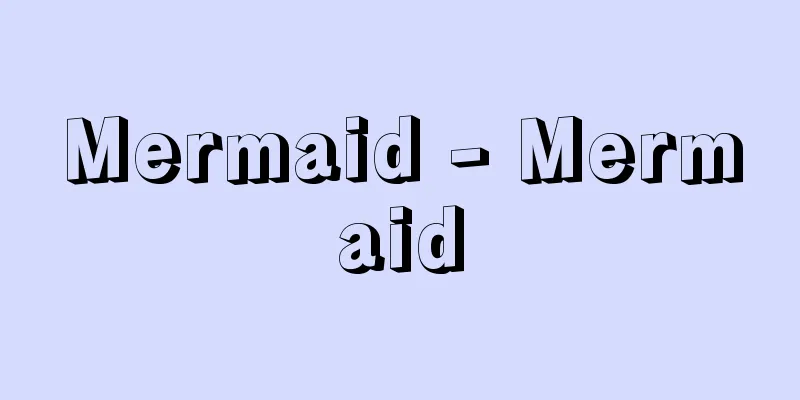Mermaid - Mermaid

|
A mythical creature with the upper body of a human and the lower body of a fish. It is known among the maritime peoples of the world, and various legends are attached to it. In England, it is called mermaid (female) and merman (male), which means maiden of the sea and man of the sea. In France, it is called Sirene, and in Italy, it is called Sirena, both of which are said to be derived from the Greek myth of Siren (a monster with the upper body of a human and the lower body of a bird). European mermaids, famous in fairy tales by Andersen, are generally beautiful women with long flowing hair, appearing on rivers and beaches on moonlit nights and singing with beautiful voices. When a sailor or ship approaches, captivated by it, it is said that they are pulled underwater or the ship is sunk. In the Chinese book "Shan Hai Jing," it is written that mermaids are shaped like catfish, have four legs, and cry like a human baby. Also, a note in that passage explains that mermaids are herring. It is said that when the First Emperor of Qin was buried, a lamp was lit with mermaid oil, and this is likely to have been a herring. In Japan, the Wamyō Ruijūshō states that "Mermaids are creatures with the body of a fish and a human face." There are ancient records of people seeing them, and the Kokonchōmonjū is the most detailed account. In Ise Province, a mermaid was caught in a fisherman's net. It had the body of a fish, the head of a human, fine fish teeth, and a face similar to that of a monkey. It cried like a human and shed tears. When people tried to eat it, it was said to taste exceptional. The story of eating a mermaid is passed down among the people as the legend of Happyakubikuni. It is said that as a result of eating it, a person lived to be 800 years old. There are also records which explain the appearance of mermaids as a sign of evil. There is a theory that mermaids are actually dugongs or oarfish, but this is unreasonable considering the ocean areas they inhabit. They should be considered a part of myths and legends. [Junichi Nomura] It was created based on Andersen's fairy tale "The Little Mermaid." It was made by sculptor E. Eriksson and is about 80cm tall. It is a beloved symbol of Copenhagen. It is located in the northeastern part of Copenhagen harbor. Denmark Copenhagen ©Shogakukan "> Little Mermaid Statue Source: Shogakukan Encyclopedia Nipponica About Encyclopedia Nipponica Information | Legend |
|
上半身が人間で、下半身が魚の形をした空想上の動物。世界の海洋国民の間に知られていて、さまざまな伝説が付加されている。イギリスではマーメイド(女性)mermaid、マーマン(男性)mermanと男女別の呼び名をもっている。海の乙女、海の男といった意味である。フランスではシレーヌ、イタリアではシレーナとよばれ、いずれもギリシア神話のセイレンSeiren(上半身人間、下半身鳥の怪物)からきたものという。アンデルセンの童話などでも有名なヨーロッパの人魚は、一般に美人で長い髪をなびかせ、月夜に川や海辺に姿を現し、美しい声で歌をうたう。それに魅せられた船乗りや船が近づくと、水中に引き込まれたり船を沈められたりするという。中国の『山海経(せんがいきょう)』という書物に、人魚は形はナマズに似て四つ足で、人間の赤子のような声で鳴くと記されている。また、そのところの注に、人魚は鯢(さんしょううお)との説明がある。秦(しん)の始皇帝を葬ったとき、人魚のあぶらで灯(ひ)をともしたというが、それは鯢のことらしい。日本では『倭名類聚抄(わみょうるいじゅしょう)』に「人魚、魚身人面の者なり」とある。実際に見たという記録は古くからあり、そのなかでも『古今著聞集(ここんちょもんじゅう)』に詳しい。伊勢(いせ)国で漁夫の網に人魚がかかり、魚身で頭は人間、歯は細かい魚の歯で、顔は猿に似ていた。人間のような泣き声で涙を流していた。食べてみると味は格別であったという。人魚を食べたという話は、民間では八百比丘尼(はっぴゃくびくに)の伝説として伝えている。食べた結果、800歳までも長生きしたという。ほかにも人魚の出現を悪いことの兆候と説いた記録もある。 人魚の正体をジュゴンやリュウグウノツカイであるとする説もあるが、生息海域から考えて無理なところがある。神話、説話の領域の存在と考えるべきであろう。 [野村純一] アンデルセンの童話『人魚姫』をもとにつくられた。彫刻家E. エリクソンの作で、像高約80cm。コペンハーゲンのシンボルとして親しまれている。コペンハーゲン港北東部にある。デンマーク コペンハーゲン©Shogakukan"> 人魚姫の像 出典 小学館 日本大百科全書(ニッポニカ)日本大百科全書(ニッポニカ)について 情報 | 凡例 |
Recommend
Indirect photography - photofluorography
A method of reducing and photographing the X-ray i...
Runaway - elopement
Leaving one's address without permission and g...
Native species - native species
〘noun〙 A variety that has been bred or cultivated ...
Concert Lamoureux (English)
...The most important achievement of this was the...
Toadbill - Toadbill
…It is found in the Malay Peninsula, Sumatra, and...
Bride - Kashou
A woman who dies before her wedding is forced to m...
Montpelier
The capital of the state of Vermont in the United ...
Katun [river] - Katun
The Ob River is a large river in Western Siberia,...
Olgierd - Olgierd
…son of Grand Duke Gediminas. Also called Olgierd...
Flower Vocabulary - Kai
...This book also includes dialectal descriptions...
Traumatic dislocation
…Pathological dislocations are caused by deformat...
Takaishi [city] - Takaishi
A city in central Osaka Prefecture, facing Osaka B...
Auden group
A group of British poets in the 1930s who showed s...
Ipsos
…An important battle during the War of Succession...
Karf, D.
…It is a psychotherapy technique that was first i...









